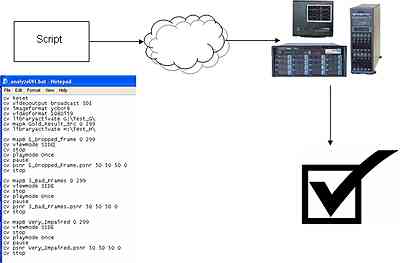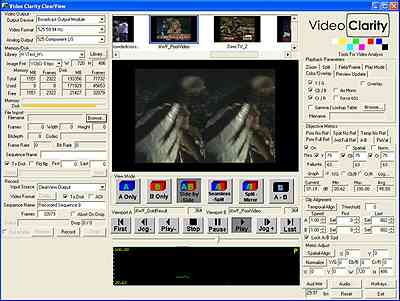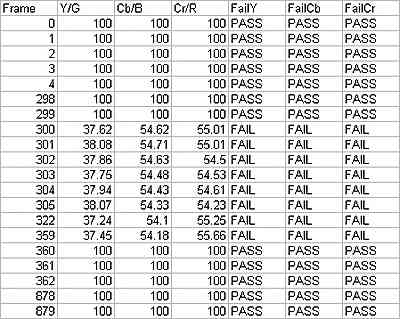As video devices become more complex and the time to market becomes shorter, quality assurance (QA) and quality control (QC) testers test more features in less time. Usually testers and just some basic functions are cluttered. What is the result of the video quality test? Do you know that your system has some performance flaws and distortions?
This article refers to the address: http://
Video quality testing during design and manufacturing
With the advent of digital television (DTV), video processing has changed dramatically. Almost all video is compressed, quantized, distributed via broadcast and IP, and decompressed. This provides an opportunity for video technology vendors.
However, the speed at which these opportunities arise is extremely dangerous. The average time-to-market for high-tech equipment from concept to supply has been reduced from five to six years in the 1990s to one to two years. The first vendors to offer a high-quality product can barely be on the verge of sustainable competition. As more companies compete for each other and add more features in a short period of time, from product development speed to system verification speed, many of the product's control factors have changed.

Figure 1: ClearView GUI with pass/fail results.
In response to this demand, some testing organizations have adopted scripts, hoping to save time. Running test scripts is faster than manual testing, but how do you automate video quality analysis? Most companies use a test instrument with a "golden eye" to verify that the quality is acceptable. In addition, many smart testers prefer manual testing, and they like to spend their time on creative test cases rather than just being familiar with complex scripting languages.
Video Clarity has created a groundbreaking video quality testing solution that enables device manufacturers to increase coverage and invest more time into creative testing. The technology, called "ClearView," is an automated video quality test system with scripts. ClearView includes an uncompressed video server, a video recorder, a video playback device, and a quantitative video quality recorder. By providing all of these device capabilities on a single device, ClearView is a complete test system for advanced video quality assessment and comparison.

Figure 2: Subjective analysis display mode (vertical segmentation).
ClearView video quality analysis
Video Clarity's ClearView system provides a range of video quality analysis tools for software developers, hardware designers, QA/QC engineers, video researchers, and production and video distribution organizations. ClearView plays, videos, displays, and analyzes video sequences. The device is capable of capturing video content from any source file, digital or analog source such as SDI, HD-SDI, DVI, VGA, HDMI, component video, composite video or S-end. Regardless of the input, ClearView can receive and convert it to uncompressed 4:2:2 Y'CbCr, 4:4:4 RGB, ARGB, or RGBA. This allows codecs to be easily compared and evaluated with each other.

Figure 3: Encoder/Decoder (DUT) pass/fail video test example.
ClearView provides many mathematical models that are close to subjective quality assessment. Objective mathematical methods are classified into the following categories based on the validity of the original video signal with the highest quality:
1. Full benchmark method (FR)
2. Reduced baseline method (RR)
3. No reference method (NR)
Have you ever thought about comparing your H.264/VC-1 & MPEG-2 with others? Now you can! You can also measure video delay and audio and video lip sync.

Figure 4: The rationale behind the scriptable pass/fail score.
Basic problem of digital compression
Similar to data compression, video compression requires a compromise between disk space, video quality, and the hardware cost of decompressing video in a reasonable amount of time. However, if the video is over-compressed, visual defects will occur. This is the mission of video quality testing and measurement to accurately model video quality.
Just align the video data before any video quality measurements. The following questions about alignment will occur:
1. The processed video time is not aligned with the original video signal.
2. The processed video has a shift in the horizontal direction
3. The processed video has a shift in the vertical direction
4. The processed video has color fidelity loss
5. The processed video and audio are not synchronized. Time alignment
The objective metric video quality is frame-by-frame, so the video sequence must be time aligned. Since there is usually no color raster/calibration strip, ClearView starts with one video frame and places the frame into another frame in the video sequence with the smallest sum-of-difference. ClearView then trims to align the video sequence in time.
Spatial horizontal alignment
Interlaced video created in 1932 to reduce the jitter caused by the CRT not being able to spread throughout the screen during the refresh time. Interlaced video is also used in the digital television specification because the signal bandwidth can be reduced by half for a certain number of lines and refresh time. However, only CRT can display interlaced video. Thus, interlaced video can be displayed on DLP, LCD, and plasma TVs only by deinterlacing. Due to the effects of the deinterlacing algorithm, the processing unit will cause horizontal shifts of several pixels. ClearView includes an algorithm to determine the amount of frame shift and adjust the window size appropriately.
Vertical alignment of space
DCT-based compression algorithms - MPEG, JPEG, and VC-1 - require video to be partitioned by 16 pixels. Due to block size limitations, NTSC video is shrunk from 486 lines to 480 lines, while HD 1080 video is actually compressed to 1088 lines. A vertical offset will result from a mismatch between the size of the compressed video and the display video window. ClearView includes an algorithm to determine the frame offset and adjust the window size appropriately.
Color fidelity loss
If the video is output through an analog source (component video, composite video, or S port), a slight deviation in color will result due to the analog to digital conversion. ClearView will use a linear normalized offset to compensate for this effect.
Audio and video synchronization
In the television field, the cause of the audio and video synchronization problem is usually caused by a large amount of processing of the video portion of the television program, usually generated by video compression codec. ClearView measures the time offset between the video source and the processed A/V sequence and then provides an offset to the compression decoder to compensate for the processing delay.
Video quality assessment
Today, video device manufacturers rely on subjective verification of video quality. Subjective tests are creative but not well quantified. How to test thousands of devices? How to conduct regression testing? How to correct test equipment and add functionality based on subjective feedback?
We have asked such a question - is the human eye evaluation objective? It is pointed out that subjective video analysis can only be used as an accurate assessment of video quality (aka, providing video sequences to a group of experts). However, subjective video analysis can only be used for development and evaluation, and does not contribute to operational monitoring, production line testing, fault location, and device-specific repeatability measurements. The need for quantitative, repeatable video analysis requires objective video quality testing.
Minimum sensible difference method
ClearView uses the well-known human vision system, the Minimum Distinguish Difference (JND) method, to objectively evaluate video quality. JND predicts video quality based on algorithms that are modeled on the observations of hundreds of evaluation experts and scored based on observed distances, perceived defects, viewing angles, and TV display size.
At the beginning, record the following two video sequences:
Video source sequence
2. Processed video
Before the JND was started, the video was aligned in time and space, and the analog noise was normalized. Our JND produces an average rating score (MOS) with a score rating from 0 to 100 and less than 5 for superior video quality. (For more information on JND, check out the white paper from Sarnoff Labs).
The main purpose of calculating a JND is to automatically evaluate the observer's average assessment score, but the best way to get a user assessment is to ask them directly! The easiest way to use ClearView is to compare and compare two video sequences on the same display under the same conditions and subjectively decide which one is better. The video can be displayed in separate screens, seamlessly split screens, mirrored split screens (butterfly), or AB (source-result). Segmentation can be horizontal or vertical. Playback supports zoom, slow motion, shuttle, and pause for in-depth analysis. Some display modes are shown below.
Regression Testing
After scoring the video with JND or your own "Golden Eyes", the score can be compared to any number of units for regression testing. This video will be considered as the "gold (model)" that will be referred to later. In this example, ClearView aligns the two video sequences and compares their video quality. Any video sequence that scores below the user-defined threshold will be considered unqualified.
ClearView controls the test setup as follows:
1. ClearView provides the original video sequence to the device under test (DUT)
2. DUT processes video data
3. ClearView records the output of the DUT
4. Refer to the "Gold" sequence, ClearView aligns and normalizes the DUT
5. ClearView calculates A/V delay and offset (offset = lip sync error)
6. ClearView compares DUT sequences to "golden" sequences
7. ClearView records pass/fail per frame and produces a total pass/fail score
8. ClearView generates a log file with results
All parameter data is stored in a small log file. This log file can be played back on any ClearView machine that has access to the original video sequence to ensure a repeatable environment when anomalies are resolved. Further, these log files can be added to the regression test to ensure that these exceptions remain fixed. For added convenience, the Analysis and Charting toolset can also import log files into Microsoft Excel files for offline viewing.
GUI test and automatic script comparison
ClearView can be controlled through its GUI or its command line interface. The easiest way to use ClearView is through its interactive GUI. The result is recorded and graphed, and the video is previewed and output to an external display. This feature works better when ClearView, DUT, and engineer/testers are all in the same location. When the development and system verification teams work in different countries and use different languages, there are some details. ClearView includes a scriptable command line interface that provides the same functionality as the GUI, which adds two additional benefits:
1. Instructions can be entered from anywhere on the network that can access the ClearView system.
2. Instructions can be batch processed, have a return code, dated, and recorded, reusable
Using the command line interface, a tester in the United States can detect irregularities and send reports to R&D teams in India or China. Other team members can access the ClearView logs, then copy and process them. Language problems are minimized and system verification can be done around the clock.
Conclusion of this paper
Video quality testing is a challenge. The performance of video processing systems varies widely and is related to the dynamic nature of the input video signal, such as a large amount of motion or spatial detail. By integrating video servers, video recorders, video players, and video quality analyzers into a system with an interactive GUI and an auto-scriptable interface, video clarity becomes an objective video quality analysis that also makes Regression testing has become a reality.
white household candles with shrink cellophane packing ,made of paraffin wax and stearic acid .pure white color ,snow white color ,off white color candle you can choose .
stick pillar shape .10-95gram/pc we all produce .our brand it is tower of golden ,holy brand
OEM brand .and do client require size
candle packing way popular : 10pcs/bag x 50bag/ctn 8pcs/bag x 30bag/ctn 6pcs/bag x 50bag/ctn 8pcs/bag x 65bag/ctn
8pcs/bag x 25bag/ctn
shipment is very quickly ,and after 30days when get the depsoit .
White Candles,Small White Candles,White Pillar Candle,White Tealight Candles
Shijiazhuang Zhongya Candle Co,. Ltd. , http://www.zycandlefactory.com
